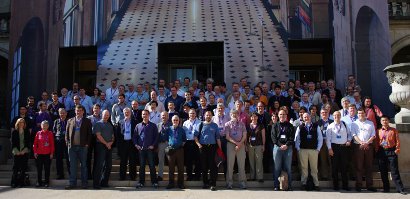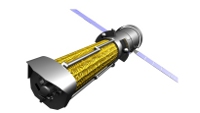Scientists discuss progress in next generation X-ray observatory
18 May 2010
Despite their travel arrangements being thrown into chaos by the eruption of the Eyjafjallajökull volcano in Iceland, nearly 200 participants from around the world came together recently at the Cité Universitaire in Paris, for the Second International X-ray Observatory (IXO) Science Meeting. This was a timely opportunity to review the progress that has been made on IXO in a number of areas.IXO is a next-generation space observatory which has been proposed as a joint project involving Europe, the United States and Japan. It is a candidate L-class (large) mission in ESA's Cosmic Vision 2015-2025 programme. In order to address some of the most fundamental questions in contemporary astrophysics and cosmology, including the behaviour of matter and energy under extreme conditions, IXO will provide major advances in X-ray imaging, timing and spectroscopy.
 |
|
Participants at the second IXO science meeting. Credit: ESA |
The meeting, held 27-29 April, began with an overview of the mission, and included updates on the ongoing ESA industrial assessment studies, as well as possible contributions to the mission from ESA, NASA and Japan. There were also presentations on the ground-breaking technologies that are being developed for the telescope, notably the silicon pore optics and glass optics that it is hoped will provide the necessary low mass, large aperture and high angular resolution.
 |
 |
|
ESA spacecraft concept for the International X-ray Observatory. Credit: ESA |
Silicon pore optics stacks used to create an IXO mirror module. Credit: ESA/cosine Research/SPO consortium |
Most of the meeting was taken up with lively, wide-ranging talks on the key scientific issues that will be addressed by IXO. A number of over-arching science themes were identified:
- What happens close to a black hole?
- When and how did supermassive black holes grow?
- How does the large scale structure of galaxies and galaxy clusters evolve?
- What is the connection between these processes?
These themes will be developed over the coming months into a strong scientific case for IXO to be considered for selection as an L-class mission within ESA's Cosmic Vision 2015-2025 programme.
The Chair of the International Study Group, Prof. Kirpal Nandra (Imperial College, London), closed the meeting by charting the way forward.
"There are four main requirements if IXO is to progress into the next phase,"he said. "First of all, we need to emphasise the exciting science that can be undertaken with IXO. The Observatory must have a robust design that is capable of delivering the science requirements. This requires the successful development of appropriate technologies, together with a realistic schedule and affordable costs. I think I can safely say that substantial progress in all of these areas is being made."
Background
The International X-ray Observatory is a proposed X-ray space telescope with joint participation from the ESA, NASA and the Japanese Aerospace Exploration Agency (JAXA). The project supersedes ESA's XEUS and NASA's Constellation-X mission concepts, which were merged in 2008. In 2009, ESA issued an Invitation to Tender to Industry, resulting in parallel industrial assessment studies. These studies are expected to be completed by the summer of 2010.
IXO's mirror assembly will offer an effective collecting area more than 10 times larger than current X-ray missions. The Observatory will also provide spectroscopic capabilities that are more than 100 times more sensitive than current missions.
All oral presentations from the April 2010 IXO Science Meeting are available in PDF format from the meeting website (see link in right-hand menu).

